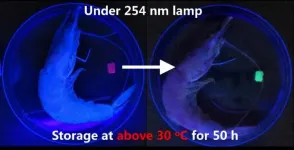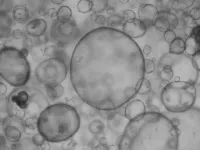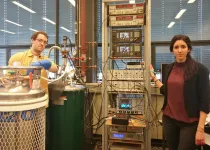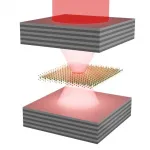Artificial color-changing material that mimics chameleon skin can detect seafood freshness
2021-05-06
(Press-News.org) Scientists in China and Germany have designed an artificial color-changing material that mimics chameleon skin, with luminogens (molecules that make crystals glow) organized into different core and shell hydrogel layers instead of one uniform matrix. The findings, published May 6 in the journal Cell Reports Physical Science, demonstrate that a two-luminogen hydrogel chemosensor developed with this design can detect seafood freshness by changing color in response to amine vapors released by microbes as fish spoils. The material may also be used to advance the development of stretchable electronics, dynamic camouflaging robots, and anticounterfeiting technologies.
"This novel core-shell layout does not require a careful choice of luminogen pairs, nor does it require an elaborate design and regulation of the complex photophysical interactions between different luminogens," says Tao Chen, a professor at the Ningbo Institute of Materials Technology and Engineering at the Chinese Academy of Sciences and an author of the study. "These advantages are important to the future construction of robust multicolor material systems with as-yet-unachieved performance."
While scientists have long envisioned developing soft materials that can fluctuate between a wide range of fluorescent colors with ease, synthetic materials are rarely able to change hue as artfully as chameleons do.
"Most artificial color-changing soft materials have been prepared by simultaneously incorporating two or more responsive luminogens into one single elastomer or hydrogel matrix," says Chen. "On the other hand, the organization of different iridophores into two superposed core-shell structured layers constitutes an evolutionary novelty for panther chameleons that allows their skins to display complex structural colors."
To determine whether artificial color-changing materials could be imbued with the natural core-shell structure of chameleon skin, Wei Lu, a researcher at the Ningbo Institute of Materials Technology and Engineering at the Chinese Academy of Sciences, and colleagues developed a multi-luminogen layered hydrogen system from the inside out. First, the researchers synthesized a red fluorescent core hydrogel, which would serve as a template for the other layers. This core hydrogel was incubated in various aqueous Europium solutions, after which the gel was incubated in a growth solution containing sodium alginate and responsive blue/green fluorescent polymers. Spontaneous diffusion of Europium ions from the core hydrogel into the surrounding solution triggered the formation of blue and green hydrogel layers.
Because of the way that the core and shell layers of the hydrogels overlapped, they could change from red to blue or green when triggered by changes in temperature or pH. The authors also note that the emission color of the blue and green fluorescent layers could be adjusted, enabling the material to display colors from nearly the full visible spectrum.
"The proposed diffusion-induced interfacial polymerization to prepare core-shell materials proves to be general," says Chen. "It is thus highly expected that the proposed synthetic strategy could be expanded to produce other soft color-changing materials, such as smart hydrogels or elastomers with stimuli-responsive structural color or pigment color change."
To test the abilities of a chemosensor crafted from a two-luminogen hydrogel to detect seafood freshness, Lu and colleagues sealed test strips made from the material in boxes with fresh shrimp or fish for 50 hours. The test strip stored with seafood at less than -10?C barely changed from its original red fluorescent color, indicating that the food was still fresh, while the test strip stored with seafood at 30?C shifted to a vivid green hue, indicating that the food had spoiled.
Chen suggests that both the novel core-shell hydrogels and the diffusion-induced interfacial polymerization strategy used to make them could prove useful in a diverse range of scientific fields, including robotics.
"In the near future, we plan to utilize the developed chameleon skin-like core-shell hydrogels to prepare biomimetic soft camouflaging skins, which can be used to mimic the diverse color-changing functions of living organisms' skins and to help achieve desirable active camouflage, display and alarm functions in robots," says Chen.
INFORMATION:
This work was supported by the National Natural Science Foundation of China, the Sino-German Mobility Program, the Key Research Program of Frontier Sciences, Chinese Academy of Sciences, the Youth Innovation Promotion Association of Chinese Academy of Sciences, and the Open Fund of the Guangdong Provincial Key, Laboratory of Luminescence from Molecular Aggregates, South China University of Technology.
Cell Reports Physical Science, Lu et al.: "Panther Chameleon skin-inspired core@shell supramolecular hydrogel with spatially organized multi-luminogens enables programmable color change" https://www.cell.com/cell-reports-physical-science/fulltext/S2666-3864(21)00107-7
Cell Reports Physical Science (@CellRepPhysSci), published by Cell Press, is a new broad-scope, open access journal that publishes cutting-edge research across the spectrum of the physical sciences, including chemistry, physics, materials science, energy science, engineering, and related interdisciplinary work. Visit: https://www.cell.com/cell-reports-physical-science/home. To receive Cell Press media alerts, please contact press@cell.com.
[Attachments] See images for this press release:

ELSE PRESS RELEASES FROM THIS DATE:
2021-05-06
Mini-organs or organoids play a big role in the future of medicine. Their countless applications can help develop and implement tailored therapies for each patient. The revolutionary development of organoids started in Utrecht with a group of curious scientists. But when organoid research starting booming, confusion arose. What exactly is an organoid? Are there different types, and if so, what should they be called? A group of experts from around the world now publishes the first consensus on what is - and what is not - an organoid.
Bart Spee, Associate Professor at Utrecht University's faculty of Veterinary Medicine, is ...
2021-05-06
The "Third Pole" of the Earth, the high mountain ranges of Asia, bears the largest number of glaciers outside the polar regions. A Sino-Swiss research team has revealed the dramatic increase in flood risk that could occur across Earth's icy Third Pole in response to ongoing climate change. Focusing on the threat from new lakes forming in front of rapidly retreating glaciers, a team, led by researchers from the University of Geneva (UNIGE), Switzerland, demonstrated that the related flood risk to communities and their infrastructure could almost triple. ...
2021-05-06
New research by Joseph Wu, Edgar Engelman, and colleagues at Stanford University, US has advanced an old concept to develop a new strategy to train the immune system of mice to recognize cancer cells. This work is based on the recent understanding that induced pluripotent stem cells (iPSCs), which are stem cells generated from skin or blood cells through a method called reprogramming, produce a large set of antigens that have overlap to a specific type of pancreatic cancer and that these similarities can be used for potential clinical benefit.
It is well known that vaccines can be highly effective ...
2021-05-06
In spintronics, the magnetic moment of electrons (spin) is used to transfer and manipulate information. An ultra-compact 2D spin-logic circuitry could be built from 2D materials that can transport the spin information over long distances and also provide strong spin-polarization of charge current. Experiments by physicists at the University of Groningen (The Netherlands) and Colombia University (USA) suggest that magnetic graphene can be the ultimate choice for these 2D spin-logic devices as it efficiently converts charge to spin current and can transfer this strong spin-polarization ...
2021-05-06
At extremely low temperatures, matter often behaves differently than in normal conditions. At temperatures only a few degrees above absolute zero (-273 degrees Celsius), physical particles may give up their independence and merge for a short time into a single object in which all the particles share the same properties. Such structures are known as Bose-Einstein Condensates, and they represent a special aggregate state of matter.
An international team of researchers led by physicists Dr Carlos Anton-Solanas and Professor Christian Schneider from the UNiversity of Oldenburg has now succeeded for the first time in generating this unusual quantum state in charge carrier complexes that are closely linked ...
2021-05-06
Hydrogen-based fuels should primarily be used in sectors such as aviation or industrial processes that cannot be electrified, finds a team of researchers. Producing these fuels is too inefficient, costly and their availability too uncertain, to broadly replace fossil fuels for instance in cars or heating houses. For most sectors, directly using electricity for instance in battery electric cars or heat pumps makes more economic sense. Universally relying on hydrogen-based fuels instead and keeping combustion technologies threatens to lock in a further fossil fuel dependency ...
2021-05-06
ROCHESTER, Minn. ? Heart disease can take a number of forms, but some types of heart disease, such as asymptomatic low ejection fraction, can be hard to recognize, especially in the early stages when treatment would be most effective. The ECG AI-Guided Screening for Low Ejection Fraction, or EAGLE, trial set out to determine whether an artificial intelligence (AI) screening tool developed to detect low ejection fraction using data from an EKG could improve the diagnosis of this condition in routine practice. Study findings are published in Nature Medicine.
Systolic low ejection fraction is defined as the heart's inability to contract strongly enough with each beat to pump at least 50% of the blood from ...
2021-05-06
What The Editorial Says: JAMA Health Forum debuts this week as a peer-reviewed, open-access, online journal focused on health policy, health care systems, and global and public health. The journal has transitioned from an online health policy channel and is the newest member of the family of JAMA Network specialty journals. The editor of JAMA Health Forum is John Z. Ayanian, M.D., M.P.P., of the University of Michigan in Ann Arbor, and the deputy editor is Melinda B. Buntin, Ph.D., of the Vanderbilt University School of Medicine in Nashville, Tennessee.
Authors: John Z. Ayanian, M.D., M.P.P., of the University of Michigan in Ann Arbor, is the corresponding author.
To access the embargoed study: Visit our For The Media website at ...
2021-05-06
What The Study Did: Researchers compared health care use among patients with COVID-19 who were enrolled in a home monitoring program with similar patients who were not enrolled.
Authors: Anita D. Misra-Hebert, M.D., M.P.H., of the Cleveland Clinic, is the corresponding author.
To access the embargoed study: Visit our For The Media website at this link https://media.jamanetwork.com/
(doi:10.1001/jamahealthforum.2021.0333)
Editor's Note: The article includes conflict of interest and funding/support disclosures. Please see the article for additional information, including other authors, author contributions and affiliations, conflict of interest and financial disclosures, and funding and support.
INFORMATION:
Media advisory: The full study and editor's ...
2021-05-06
New York, NY (May 6, 2021) -- Researchers have finally cracked the code of a bewildering pediatric disease that sets off a characteristic cytokine storm--a harmful immune system overaction resembling one that arises in COVID-19 cases--and can lead to catastrophic multisystem organ failure or neurodegeneration. Their study, which identifies the cause of the cytokine storm and possible treatments, was published in Nature Medicine in May.
The mystery of this disease, Langerhans-cell histiocytosis (LCH), runs deep. Its symptoms vary widely, and LCH has the ability to infiltrate almost any organ system, leaving most patients with long-term ...
LAST 30 PRESS RELEASES:
[Press-News.org] Artificial color-changing material that mimics chameleon skin can detect seafood freshness




